|
|
|
|
Home Page
Artifact # 7
|
Question 1 Context: In RE 5710, Seminar in Reading/Language Arts Research, I completed the first Comprehensive Exam entailing my classroom and current role in reading and language arts instruction. Because I am not in a full-time teaching position yet, I identified my ideal classroom and professional role as a teacher in this exam. I stated that I would ideally teach a first grade class and discussed such issues as assessment, materials, types of reading instruction, and the diverse levels of instructional needs. Based on what I have learned in my Graduate courses, I discusses the use of the Informal Reading Inventories as an assessment tool, why I would use it, and how it would help me to identify the students' reading levels in my classroom. I also noted the kinds of materials I would use and for what purposes, ie. basal readers, decodable books, trade books, etc. In order to efficiently teach reading in my classroom, I must focus on the best ways to develop comprehension and fluency skills in each of my students. I described such methods as Directed Reading Thinking Activity, repeated readings, Reading Recovery, and Early Steps. I also addressed the way I would attempt to meet the instructional needs of my students through direct instruction and/or grouping. I finalized the exam with my plan of support and teaching strategies I would use in my future classroom. Impact: This exam was a summation of the knowledge I have gained over the past two years as a graduate student in the Reading Department. It was an excellent way to put all the instruction I have gotten as a student to the test. I was able to take all I have learned and put it in a ideal situation for my future classroom. I was able to organize the information and deliver it in a way that explained how I would use the methods, theory, and principles in my own professional development as an educator. Alignment: Principle A: Instructional Expertise When completing the Comprehensive Exam 1, I demonstrated instructional expertise by applying the theoretical, philosophical, and research bases for educational practice to improve student learning by creating an ideal classroom instructional scenario. I planned, implemented, evaluated instruction that is rigorous, coherent, and consistent with a the best practices from educational research. I designed and modified instruction and learning environments based on assessment of the student learning problems and successes. I monitored the effects of instructional actions, selected materials, and other instructional decisions on students' learning and behavior and incorporated those from findings of educational literature into school and classroom strategies in order to improve student learning. I understood and linked subject matter to meet diverse needs as well as implementing and evaluating the best pedagogical practices for the subjects taught within the specific school setting. Principle B: Knowledge of Learners When planning and designing my ideal classroom for Comprehensive Exam 1, I incorporated knowledge of the nature of the learner, learning processes, variations in learning abilities and learning styles, and strategies for evaluating learning into the planning, delivery, and evaluation of instruction. I sought to increase understanding of and respect for differences in students, modified instruction that is responsive to differences among all learners, taking into consideration the differences between learning behaviors and outcomes expected in diverse communities. I created an ideal classroom environment conducive to learning in which all learners feel welcome to be successful. When compiling the information for the Comprehensive Exam, I used research to examine and improve instructional effectiveness and student achievement for my ideal classroom instruction. I critically read and applied educational literature including theoretical, philosophical, and research materials that would be sufficient for my classroom. I used student and school performance date to improve student learning, classroom processes, and school practices. Principle D: Content Knowledge The Comprehensive Exam enabled me to demonstrate advanced depth and breadth of knowledge and skills in the academic discipline and in education. I analyzed and articulated relationships between and among theory, philosophy, research findings, and current practice as appropriate to the discipline when creating my ideal classroom instructional methods. I also analyzed and articulates relationships between and among theory, philosophy, research findings, and current practices across disciplines. Through the creation of this classroom scenario, I demonstrated theoretical and applied advanced content knowledge while understanding current knowledge and trends in education.
|
